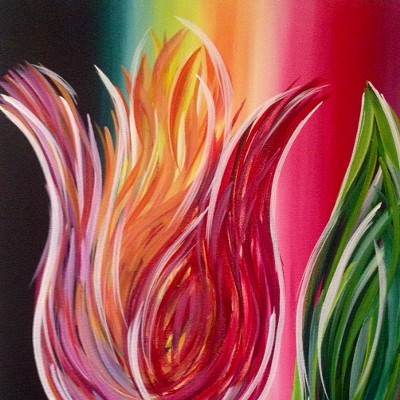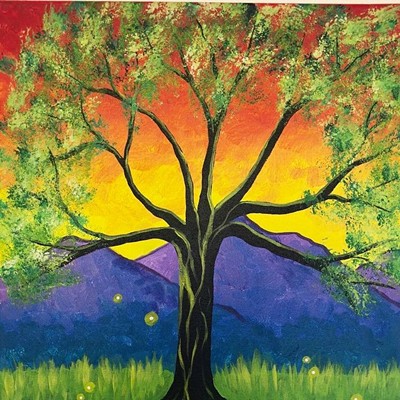His art, he writes, is
"an expression of the joy of light and the light of joy,
the form of color and the color of form,
the composition of rhythm and the rhythm of composition."
His poetic words are apt descriptions of his densely pigmented acrylics on canvas, bursting with dots of pointillist color, flying abstract shapes and swirling lines. And you can almost picture Leichter in a New York coffee house chanting his verses, maybe playing the proverbial bongos to emphasize their meter. In fact, the artist came of age in 1960s New York, a time and place of dizzying artistic ferment.
He studied art first at the city's High School of Art and Design, then put in a few years at Pratt and the School of Visual Arts. Meantime, he immersed himself in the experimental work being shown in the Big Apple galleries, says Lauren Gregersen-Brown, who's exhibiting his jewel-toned paintings at her Fala Collections gallery in Tucson's Warehouse District.
"He got a lot of attention in the '70s," she says. "He picked up a lot, early."
Following in the footsteps of the New York Abstract Expressionists, the young Leichter made "heroic-sized canvases," Gregersen-Brown says, squirting big streams of paint onto their vast expanses with condiment bottles and pastry sacks. From the beginning, the art world took notice. His résumé lists a steady stream of shows in 1970s Soho and one at the Museum of Modern Art. But then it drops off. Leichter dropped out. He left the art scene, left New York, left the United States.
Bouncing around for years, far from the fevered art market, he lived in South America for a while, then in Spain and Morocco. He even had a stint in the merchant marine, Melville-style, Gregersen-Brown says, before returning to New York. No longer a wunderkind, he kept on painting in relative obscurity, but switched from his early broad strokes and "physicality" to work that was more tightly composed.
Leichter concentrated on works on paper until 1999, when a generous grant from the Pollock-Krasner Foundation allowed him to return to painting on canvas. The results are on view in the distinctive new show at Fala. His first one-person outing in Tucson, where he moved a few years ago, the exhibition includes seven big paintings on canvas, 12 paintings on paper and four small constructions.
The paintings are a wild cross between pointillism and pattern painting, and between biomorphic and geometric forms. Swarms of painted dots cascade out from the centers, and their colors--yellows to blues to maroons--create the illusion of 3-D shapes. Quick lines of color in pink or orange--"cosmic rings," Gregersen-Brown calls them--zip over the surfaces, like a child's glow stick on a summer night. Cones, ovals, trapezoids, circles and even puzzle pieces float in and out.
The palette is crayon-bright, but blues of every shade, from chalk to sky to royal and midnight, predominate in nearly every piece. Leichter deliberately uses flat matte acrylics so that the paint itself doesn't shine, but he creates his own light through color. The pointillist dots in lemon-yellow and gold shine all by themselves, glistening like stars against the deep blue backgrounds.
Nor does he always content himself with canvases in well-behaved rectangles. He's shaped "The Unemployed Dervishes" into an arch. "Ether and Entropy" is a perfect circle.
Energetic as all this work is, it's also meticulously structured. Every work is bound by a painted frame, which in turn is given a decorative pattern: Circles and stripes in green and chalk blue frame the bright gold trapezoids of "Upon Emergent Occasions," triangles and dots in royal blue and green for "Alien Fire." The interiors are also carefully divided up into colored planes. Squared-off bands of lavender help anchor the figures of "The Unemployed Dervish," and so do a green arch at the painting's center and a deep-blue arrow at the top. The painting is as carefully put together as stained glass, an impression reinforced by its church-window shape.
But its whirling "dervishes" don't owe much to strait-laced religion. These dancing cones, striped in orange and green, rise merrily up through the careful geometries, and the bright dots of color and swirling lines that surround them zip out like confetti on New Year's Eve.
For the drawings, Leichter switches from overarching blue to underlying black. He covers the paper with black gesso, and then draws on it with colored pencil, making the same lively shapes he fashions with his paint. "Nocturnal Rendezvous" has a "frame" of chalk blue, and a series of interlacing rainbow curves at the top. Two striped cylinders head toward the middle, striped in cerulean, green, yellow and burnt orange. The darkness of the background tones down the colors somewhat, but as Gregersen-Brown notes, the drawings are about the "joyful optimism of color against black."
A charming cut-paper assemblage is like a diorama made by a precocious elementary school child. Inside the box is a tiny painting; its cut-out opening reveals layers of colored paper zooming through space. A jagged lightning bolt in cerulean zips up vertically. More cosmic rings, in yellow and flame orange, float above and below, along with a pale blue T-square, a lemon trapezoid and red-orange lips. Leichter has named the piece "This Side of Halleleya," but a better title for this blissful little work might be "This Side of Hallelujah."














